Spatio-Temporal Analysis of Drought Variability in Myanmar Based on the Standardized Precipitation Evapotranspiration Index (SPEI) and Its Impact on Crop Production
Abstract
:1. Introduction
2. Materials and Methods
2.1. Study Area
2.2. In Situ Observation Data
2.3. Methods
2.3.1. Precipitation and Temperature Climatology
2.3.2. Calculation of SPEI
2.3.3. Standardized Anomaly Estimation
2.3.4. Statistical Analysis
3. Results
3.1. Climatology and Linear Trend of Temperature and Precipitation
3.2. Spatial–Temporal Trends of Wetting and Drying
3.2.1. Temporal Variations in Wetting and Drying Trends
3.2.2. Spatial Variations in Wetting and Drying Trends
3.3. Correlation Analysis of SPEI and Its Key Mechanisms
3.4. Crop Productions and Its Influencing Factors
4. Summary and Conclusions
Supplementary Materials
Author Contributions
Funding
Institutional Review Board Statement
Informed Consent Statement
Data Availability Statement
Acknowledgments
Conflicts of Interest
Appendix A
Appendix A.1. Calculation Trends Analysis
Appendix A.2. Linear Regression Model and Correlational Analysis
Appendix A.3. Standardised Anomaly
Appendix B
| No. | Station Name | Latitude (°N) | Longitude (°E) | Elevation (m) |
|---|---|---|---|---|
| 1 | Bago | 17.2 | 96.3 | 15 |
| 2 | Belin | 17.13 | 97.14 | 61 |
| 3 | Dawei | 14.06 | 98.13 | 16 |
| 4 | Hinthada | 17.4 | 95.25 | 26 |
| 5 | Hkamti | 26 | 95.42 | 146 |
| 6 | Homalin | 24.52 | 94.55 | 130 |
| 7 | Hpa-an | 16.45 | 97.4 | 9 |
| 8 | Hsipaw | 22.6 | 97.3 | 436 |
| 9 | Kaba-Aye | 16.46 | 96.1 | 20 |
| 10 | Kalaywa | 23.12 | 94.18 | 109 |
| 11 | Katha | 24.1 | 96.2 | 113 |
| 12 | Kawthaung | 9.58 | 98.35 | 46 |
| 13 | Kengtung | 21.18 | 99.37 | 827 |
| 14 | Kyaukpyu | 19.4 | 93.6 | 5 |
| 15 | Lashio | 22.56 | 97.45 | 747 |
| 16 | Loikaw | 19.41 | 97.13 | 895 |
| 17 | Magway | 20.07 | 94.55 | 52 |
| 18 | Mandalay | 21.59 | 96.06 | 74 |
| 19 | Mawlamyine | 16.3 | 97.37 | 21 |
| 20 | Meiktila | 20.5 | 95.5 | 214 |
| 21 | Minbu | 20.1 | 94.53 | 51 |
| 22 | Mingladon | 16.54 | 96.11 | 28 |
| 23 | Monywa | 22.06 | 95.08 | 81 |
| 24 | Myeik | 12.26 | 98.36 | 36 |
| 25 | Myitkyina | 25.22 | 97.24 | 145 |
| 26 | Naungoo | 21.12 | 94.55 | 61 |
| 27 | Pathein | 16.46 | 94.46 | 9 |
| 28 | Pinlaung | 20.08 | 96.46 | 1463 |
| 29 | Putao | 27.2 | 97.25 | 409 |
| 30 | Pyay | 18.48 | 95.13 | 58 |
| 31 | Pyinmana | 19.43 | 96.13 | 101 |
| 32 | Shwebo | 22.35 | 95.43 | 106 |
| 33 | Shwegyin | 17.55 | 96.52 | 12 |
| 34 | Sittwe | 20.08 | 92.53 | 4 |
| 35 | Taunggyi | 20.47 | 97.03 | 1436 |
| 36 | Taungoo | 18.55 | 96.28 | 47 |
| 37 | Thandwe | 18.28 | 94.21 | 9 |
| 38 | Thaton | 16.55 | 97.22 | 17 |
| 39 | Yay | 15.15 | 97.52 | 3 |
References
- IPCC. Climate Change; Cambridge University Press: Cambridge, UK; New York, NY, USA, 2014. [Google Scholar]
- Hao, Z.; Singh, V.P. Drought characterization from a multivariate perspective: A review. J. Hydrol. 2015, 527, 668–678. [Google Scholar] [CrossRef]
- Mishra, A.K.; Singh, V.P. A review of drought concepts. J. Hydrol. 2010, 391, 202–216. [Google Scholar] [CrossRef]
- Nooni, I.K.; Hagan, D.F.T.; Wang, G.; Ullah, W.; Li, S.; Lu, J.; Bhatti, A.S.; Shi, X.; Lou, D.; Prempeh, N.A.; et al. Spatiotemporal Characteristics and Trend Analysis of Two Evapotranspiration-Based Drought Products and Their Mechanisms in Sub-Saharan Africa. Remote Sens. 2021, 13, 533. [Google Scholar] [CrossRef]
- WMO. Guide to Climatological Practices. Weather, Climate and Water; WMO: Geneva, Switzerland, 2011. [Google Scholar]
- Wilhite, D.A.; Glantz, M.H. Understanding: The Drought Phenomenon: The Role of Definitions. Water Int. 1985, 10, 111–120. [Google Scholar] [CrossRef] [Green Version]
- Wilhite, D.A.; Svoboda, M.D.; Hayes, M.J. Understanding the complex impacts of drought: A key to enhancing drought mitigation and preparedness. Water Resour. Manag. 2007, 21, 763–774. [Google Scholar] [CrossRef] [Green Version]
- Piao, S.; Ciais, P.; Huang, Y.; Shen, Z.; Peng, S.; Li, J.; Zhou, L.; Liu, H.; Ma, Y.; Ding, Y.; et al. The impacts of climate change on water resources and agriculture in China. Nature 2010, 467, 43–51. [Google Scholar] [CrossRef]
- Van Dijk, A.I.J.M.; Beck, H.E.; Crosbie, R.; De Jeu, R.A.M.; Liu, Y.Y.; Podger, G.M.; Timbal, B.; Viney, N. The Millennium Drought in southeast Australia (2001–2009): Natural and human causes and implications for water resources, ecosystems, economy, and society. Water Resour. Res. 2013, 49, 1040–1057. [Google Scholar] [CrossRef]
- Vicente-Serrano, S.M.; Beguería, S.; Lorenzo-Lacruz, J.; Camarero, J.J.; Lopez-Moreno, I.; Azorin-Molina, C.; Revuelto, J.; Morán-Tejeda, E.; Sanchez-Lorenzo, A. Performance of Drought Indices for Ecological, Agricultural, and Hydrological Applications. Earth Interact. 2012, 16, 1–27. [Google Scholar] [CrossRef] [Green Version]
- Heim, R.R. A Review of Twentieth-Century Drought Indices Used in the United States. Bull. Am. Meteorol. Soc. 2002, 83, 1149–1166. [Google Scholar] [CrossRef] [Green Version]
- Yihdego, Y.; Vaheddoost, B.; Al-Weshah, R. Drought indices and indicators revisited. Arab. J. Geosci. 2019, 12, 69. [Google Scholar] [CrossRef]
- Palmer, W. Meteorological Drought; US Weather Bureau: Washington, DC, USA, 1965.
- Sheffield, J.; Wood, E.; Roderick, M. Little change in global drought over the past 60 years. Nature 2012, 491, 435–438. [Google Scholar] [CrossRef]
- Dai, A. Characteristics and trends in various forms of the Palmer Drought Severity Index during 1900. J. Geophys. Res. Space Phys. 2011, 116. [Google Scholar] [CrossRef] [Green Version]
- Dai, A. Increasing drought under global warming in observations and models. Nat. Clim. Chang. 2012, 3, 52–58. [Google Scholar] [CrossRef]
- Dutta, R. Drought Monitoring in the Dry Zone of Myanmar using MODIS Derived NDVI and Satellite Derived CHIRPS Precipitation Data. Sustain. Agric. Res. 2018, 7, 46. [Google Scholar] [CrossRef] [Green Version]
- Dai, A.; Trenberth, K.E.; Qian, T. A Global Dataset of Palmer Drought Severity Index for 1870–2002: Relationship with Soil Moisture and Effects of Surface Warming. J. Hydrometeorol. 2004, 5, 1117–1130. [Google Scholar] [CrossRef]
- McKee, T.B.; Doesken, N.J.; Kleist, J. The relationship of drought frequency and duration to time scales. In Proceedings of the Eighth Conference on Applied Climatology, Anaheim, CA, USA, 17–23 January 1993; pp. 174–184. [Google Scholar]
- Alley, W.M. The Palmer drought severity index: Limitations and applications. J. Appl. Meteor. 1984, 23, 1100–1109. [Google Scholar] [CrossRef] [Green Version]
- Mechiche-Alami, A.; Abdi, A.M. Agricultural productivity in relation to climate and cropland management in West Africa. Sci. Rep. 2020, 10, 1–10. [Google Scholar] [CrossRef]
- Vicente-Serrano, S.M.; Beguería, S.; Lopez-Moreno, I. A Multiscalar Drought Index Sensitive to Global Warming: The Standardized Precipitation Evapotranspiration Index. J. Clim. 2010, 23, 1696–1718. [Google Scholar] [CrossRef] [Green Version]
- Li, W.-G.; Yi, X.; Hou, M.-T.; Chen, H.-L.; Chen, Z.-L. Standardized precipitation evapotranspiration index shows drought trends in China. Chin. J. Eco-Agric. 2012, 20, 643–649. [Google Scholar] [CrossRef]
- Jia, Y.; Zhang, B.; Ma, B. Daily SPEI Reveals Long-term Change in Drought Characteristics in Southwest China. Chin. Geogr. Sci. 2018, 28, 680–693. [Google Scholar] [CrossRef] [Green Version]
- Kambombe, O.; Ngongondo, C.; Eneya, L.; Monjerezi, M.; Boyce, C. Spatio-temporal analysis of droughts in the Lake Chilwa Basin, Malawi. Theor. Appl. Clim. 2021, 144, 1219–1231. [Google Scholar] [CrossRef]
- Li, S.; Yao, Z.; Wang, R.; Liu, Z. Dryness/wetness pattern over the Three-River Headwater Region: Variation characteristic, causes, and drought risks. Int. J. Clim. 2019, 40, 3550–3566. [Google Scholar] [CrossRef]
- Liu, C.; Yang, C.; Yang, Q.; Wang, J. Spatiotemporal drought analysis by the standardized precipitation index (SPI) and standardized precipitation evapotranspiration index (SPEI) in Sichuan Province, China. Sci. Rep. 2021, 11, 1–14. [Google Scholar] [CrossRef]
- Ma, B.; Zhang, B.; Jia, L.; Huang, H. Conditional distribution selection for SPEI-daily and its revealed meteorological drought characteristics in China from 1961 to 2017. Atmos. Res. 2020, 246, 105108. [Google Scholar] [CrossRef]
- Li, X.; Huang, W.-R. How long should the pre-existing climatic water balance be considered when capturing short-term wetness and dryness over China by using SPEI? Sci. Total Environ. 2021, 786, 147575. [Google Scholar] [CrossRef]
- Tefera, A.S.; Ayoade, J.O.; Bello, N.J. Comparative analyses of SPI and SPEI as drought assessment tools in Tigray Region, Northern Ethiopia. SN Appl. Sci. 2019, 1, 1265. [Google Scholar] [CrossRef] [Green Version]
- Wang, Q.; Shi, P.; Lei, T.; Geng, G.; Liu, J.; Mo, X.; Li, X.; Zhou, H.; Wu, J. The alleviating trend of drought in the Huang-Huai-Hai Plain of China based on the daily SPEI. Int. J. Clim. 2015, 35, 3760–3769. [Google Scholar] [CrossRef]
- Wang, Q.; Zeng, J.; Qi, J.; Zhang, X.; Zeng, Y.; Shui, W.; Xu, Z.; Zhang, R.; Wu, X.; Cong, J. A multi-scale daily SPEI dataset for drought characterization at observation stations over mainland China from 1961 to 2018. Earth Syst. Sci. Data 2021, 13, 331–341. [Google Scholar] [CrossRef]
- Wang, W.; Guo, B.; Zhang, Y.; Zhang, L.; Ji, M.; Xu, Y.; Zhang, X.; Zhang, Y. The sensitivity of the SPEI to potential evapotranspiration and precipitation at multiple timescales on the Huang-Huai-Hai Plain, China. Theor. Appl. Clim. 2020, 143, 87–99. [Google Scholar] [CrossRef]
- Wu, M.; Li, Y.; Hu, W.; Yao, N.; Li, L.; Liu, D.L. Spatiotemporal variability of standardized precipitation evapotranspiration index in mainland China over 1961–2016. Int. J. Clim. 2020, 40, 4781–4799. [Google Scholar] [CrossRef]
- Zhang, R.; Chen, T.; Chi, D. Global Sensitivity Analysis of the Standardized Precipitation Evapotranspiration Index at Different Time Scales in Jilin Province, China. Sustainability 2020, 12, 1713. [Google Scholar] [CrossRef] [Green Version]
- Katchele, O.F.; Ma, Z.-G.; Yang, Q.; Batebana, K. Comparison of trends and frequencies of drought in central North China and sub-Saharan Africa from 1901 to 2010. Atmos. Ocean. Sci. Lett. 2017, 10, 418–426. [Google Scholar] [CrossRef] [Green Version]
- Lobell, D.B.; Schlenker, W.; Costa-Roberts, J. Climate Trends and Global Crop Production Since 1980. Science 2011, 333, 616–620. [Google Scholar] [CrossRef] [Green Version]
- Fahad, S.; Bajwa, A.; Nazir, U.; Anjum, S.A.; Farooq, A.; Zohaib, A.; Sadia, S.; Nasim, W.; Adkins, S.; Saud, S.; et al. Crop Production under Drought and Heat Stress: Plant Responses and Management Options. Front. Plant Sci. 2017, 8, 1147. [Google Scholar] [CrossRef] [Green Version]
- Geng, G.; Wu, J.; Wang, Q.; Lei, T.; He, B.; Li, X.; Mo, X.; Luo, H.; Zhou, H.; Liu, D. Agricultural drought hazard analysis during 1980–2008: A global perspective. Int. J. Clim. 2015, 36, 389–399. [Google Scholar] [CrossRef]
- Wang, Q.; Wu, J.; Lei, T.; He, B.; Wu, Z.; Liu, M.; Mo, X.; Geng, G.; Li, X.; Zhou, H.; et al. Temporal-spatial characteristics of severe drought events and their impact on agriculture on a global scale. Quat. Int. 2014, 349, 10–21. [Google Scholar] [CrossRef]
- Hunt, E.D.; Svoboda, M.; Wardlow, B.; Hubbard, K.; Hayes, M.; Arkebauer, T. Monitoring the effects of rapid onset of drought on non-irrigated maize with agronomic data and climate-based drought indices. Agric. For. Meteorol. 2014, 191, 1–11. [Google Scholar] [CrossRef]
- Páscoa, P.; Gouveia, C.M.; Russo, A.; Trigo, R.M. The role of drought on wheat yield interannual variability in the Iberian Peninsula from 1929 to 2012. Int. J. Biometeorol. 2016, 61, 439–451. [Google Scholar] [CrossRef]
- Karim, R.; Rahman, M.A. Drought risk management for increased cereal production in Asian Least Developed Countries. Weather. Clim. Extrem. 2015, 7, 24–35. [Google Scholar] [CrossRef] [Green Version]
- Knox, J.; Hess, T.; Daccache, A.; Wheeler, T. Climate change impacts on crop productivity in Africa and South Asia. Environ. Res. Lett. 2012, 7, 034032. [Google Scholar] [CrossRef]
- Liu, X.; Pan, Y.; Zhu, X.; Yang, T.; Bai, J.; Sun, Z. Drought evolution and its impact on the crop yield in the North China Plain. J. Hydrol. 2018, 564, 984–996. [Google Scholar] [CrossRef]
- Lobell, D.; Sibley, A.M.; Ortiz-Monasterio, J.I. Extreme heat effects on wheat senescence in India. Nat. Clim. Chang. 2012, 2, 186–189. [Google Scholar] [CrossRef]
- Madadgar, S.; AghaKouchak, A.; Farahmand, A.; Davis, S.J. Probabilistic estimates of drought impacts on agricultural production. Geophys. Res. Lett. 2017, 44, 7799–7807. [Google Scholar] [CrossRef]
- Mangani, R.; Tesfamariam, E.; Bellocchi, G.; Hassen, A. Modelled impacts of extreme heat and drought on maize yield in South Africa. Crop. Pasture Sci. 2018, 69, 703. [Google Scholar] [CrossRef]
- Oo, A.T.; Van Huylenbroeck, G.; Speelman, S. Measuring the Economic Impact of Climate Change on Crop Production in the Dry Zone of Myanmar: A Ricardian Approach. Climate 2020, 8, 9. [Google Scholar] [CrossRef] [Green Version]
- FAO. The State of Food and Agriculture 2016; Food and Agriculture of the United Nations: Rome, Italy, 2016. [Google Scholar]
- FAO. FAOSTAT on the UN, Myanmar; Food and Agriculture Organization of the United Nations (FAO): Rome, Italy, 2018; Available online: http://faostat.fao.org/CountryProfiles/Country_Profile/Direct.aspx?lang=en&area=28 (accessed on 30 May 2021).
- Gebreegziabher, Z.; Mekonnen, A.; Bekele, R.D.; Zewdie, S.A.; Kassahun, M.M. Crop-Livestock Inter-Linkages and Climate Change Implications for Ethiopia’s Agriculture. Environment for Development Discussion Paper Series EfD DP 13–14; Springer: Cham, Switzerland, 2013; 32p. [Google Scholar] [CrossRef]
- Sein, Z.M.; Ullah, I.; Saleem, F.; Zhi, X.; Syed, S.; Azam, K. Interdecadal Variability in Myanmar Rainfall in the Monsoon Season (May–October) Using Eigen Methods. Water 2021, 13, 729. [Google Scholar] [CrossRef]
- Sein, Z.M.; Ullah, I.; Syed, S.; Zhi, X.; Azam, K.; Rasool, G. Interannual Variability of Air Temperature over Myanmar: The Influence of ENSO and IOD. Climate 2021, 9, 35. [Google Scholar] [CrossRef]
- Sein, Z.M.M.; Zhi, X. Interannual variability of summer monsoon rainfall over Myanmar. Arab. J. Geosci. 2016, 9, 469. [Google Scholar] [CrossRef]
- Paing Oo, S. Farmers’ Awareness of the Low Yield of Conventional Rice Production in Ayeyarwady Region, Myanmar: A Case Study of Myaungmya District. Agriculture 2020, 10, 26. [Google Scholar] [CrossRef] [Green Version]
- Matsuda, M. Upland Farming Systems Coping with Uncertain Rainfall in the Central Dry Zone of Myanmar: How Stable is Indigenous Multiple Cropping Under Semi-Arid Conditions? Hum. Ecol. 2013, 41, 927–936. [Google Scholar] [CrossRef]
- DIVA-GIS Homepage. Download Data by Country. Available online: https://diva-gis.org/ (accessed on 30 May 2021).
- Department of Meteorology and Hydrology, Ministry of Transport. Myanmar’s National Adaptation Programme of Action (NAPA) to Climate Change; The Republic Union of Myanmar, National Environmental Conservation Committee, Ministry of Environmental Conservation and Forestry: Nay Pyi Taw, Myanmar, 2012; pp. 1–126.
- Marchant, R.; Richer, S.; Boles, O.; Capitani, C.; Mustaphi, C.C.; Lane, P.; Prendergast, M.E.; Stump, D.; De Cort, G.; Kaplan, J.O.; et al. Drivers and trajectories of land cover change in East Africa: Human and environmental interactions from 6000 years ago to present. Earth-Sci. Rev. 2018, 178, 322–378. [Google Scholar] [CrossRef]
- Yi, T.; Hla, W.M.; Htun, A.K. Drought Conditions and Management Strategies in Myanmar. In Report of the Department of Meteorology and Hydrology, Myanmar; Department of Meteorology and Hydrology, Ministry of Transport: Nay Pyi Taw, Myanmar, 2014. [Google Scholar]
- UNDP. Enhancing Capacities for Climate Risk Management in Myanmar’s Dry Zone through Climate Information and Services; UNDP: New York, NY, USA, 2018; Available online: https://www.adaptation-fund.org/ie/united-nations-development-programme-undp/ (accessed on 21 March 2021).
- Trenberth, K.E. ENSO in the Global Climate System. In El Niño Southern Oscillation in a Changing Climate; John Wiley & Sons: Hoboken, NJ, USA, 2020; pp. 21–37. [Google Scholar]
- NOAA, Physical Sciences Laboratory Homepge, Nino SST Indices (Nino 3.4), Mean Using Ersstv5 from CPC (Trenberth 2020) and Dipole Mode Index (DMI) HadISST1.1. Available online: https://psl.noaa.gov/data/timeseries/ (accessed on 30 May 2021).
- FAOSTAT. FAO Statistics Data Base on the World Wide Web; FAO: Rome, Italy, 2021; Available online: http://faostat.fao.org (accessed on 19 May 2021).
- ESRI Home. ArcGIS Desktop: Release Redlands; Environmental Systems Research Institute: Redlands, CA, USA; Available online: https://www.esri.com (accessed on 21 March 2021).
- Thornthwaite, C.W. An Approach toward a Rational Classification of Climate. Geogr. Rev. 1948, 38, 55. [Google Scholar] [CrossRef]
- R Development Core Team. R: A Language and Environment for Statistical Computing. R Foundation for Statistical Computing, Vienna. Available online: https://www.yumpu.com/en/document/read/6853895/r-a-language-and-environment-for-statistical-computing (accessed on 21 March 2021).
- Mann, H.B. Nonparametric Tests Against Trend. Econometrica 1945, 13, 245. [Google Scholar] [CrossRef]
- Nooni, I.K.; Wang, G.; Hagan, D.F.T.; Lu, J.; Ullah, W.; Li, S. Evapotranspiration and its Components in the Nile River Basin Based on Long-Term Satellite Assimilation Product. Water 2019, 11, 1400. [Google Scholar] [CrossRef] [Green Version]
- Ullah, W.; Wang, G.; Ali, G.; Hagan, D.F.T.; Bhatti, A.S.; Lou, D. Comparing Multiple Precipitation Products against In-Situ Observations over Different Climate Regions of Pakistan. Remote Sens. 2019, 11, 628. [Google Scholar] [CrossRef] [Green Version]
- Ullah, W.; Wang, G.; Lou, D.; Ullah, S.; Bhatti, A.S.; Karim, A.; Hagan, D.F.T.; Ali, G. Large-scale atmospheric circulation patterns associated with extreme monsoon precipitation in Pakistan during 1981–2014. Atmos. Res. 2021, 253, 105489. [Google Scholar] [CrossRef]
- Sian, K.L.K.; Wang, J.; Ayugi, B.; Nooni, I.; Ongoma, V. Multi-Decadal Variability and Future Changes in Precipitation over Southern Africa. Atmosphere 2021, 12, 742. [Google Scholar] [CrossRef]
- Bärring, L.T.; Holt, M.L.; Linderson, M.; Radziejewski, M.; Moriondo, J.; Palutikof, P. Defining dry/wet spells for point observations, observed area averages, and regional climate model grid boxes in europe. Clim. Res. 2006, 31, 35–49. [Google Scholar] [CrossRef] [Green Version]
- Manzano, A.; Clemente, M.A.; Morata, A.; Luna, M.Y.; Beguería, S.; Vicente-Serrano, S.M.; Martín, M.L. Analysis of the atmospheric circulation pattern effects over SPEI drought index in Spain. Atmos. Res. 2019, 230, 104630. [Google Scholar] [CrossRef]
- GIEWS/FAO. FAO/WFP Crop and Food Security Assessment Mission to Myanma; FAO: Rome, Italy; Wfp: Rome, Italy, 2016. [Google Scholar]
- Hina, S.; Saleem, F.; Arshad, A.; Hina, A.; Ullah, I. Droughts over Pakistan: Possible cycles, precursors and associated mechanisms. Geomat. Nat. Hazards Risk 2021, 12, 1638–1668. [Google Scholar] [CrossRef]
- Hawkins, E.; Fricker, T.E.; Challinor, A.; Ferro, C.A.T.; Ho, C.K.; Osborne, T.M. Increasing influence of heat stress on French maize yields from the 1960s to the 2030s. Glob. Chang. Biol. 2012, 19, 937–947. [Google Scholar] [CrossRef] [PubMed] [Green Version]
- Asseng, S.; Foster, I.; Turner, N. The impact of temperature variability on wheat yields. Glob. Chang. Biol. 2011, 17, 997–1012. [Google Scholar] [CrossRef]
- IPCC. Climate Change: The Physical Science Basis-Summary for Policymakers; IPCC: Geneva, Switzerland, 2007; p. 21. [Google Scholar]
- Fontaine, B.; Roucou, P.; Monerie, P.-A. Changes in the African monsoon region at medium-term time horizon using 12 AR4 coupled models under the A1b emissions scenario. Atmos. Sci. Lett. 2011, 12, 83–88. [Google Scholar] [CrossRef]
- Herridge, D.F.; Win, M.M.; Nwe, K.M.M.; Kyu, K.L.; Win, S.S.; Shwe, T.; Min, Y.Y.; Denton, M.; Cornish, P.S. The cropping systems of the Central Dry Zone of Myanmar: Productivity constraints and possible solutions. Agric. Syst. 2018, 169, 31–40. [Google Scholar] [CrossRef]
- Ray, D.K.; Gerber, J.; MacDonald, G.; West, P. Climate variation explains a third of global crop yield variability. Nat. Commun. 2015, 6, 5989. [Google Scholar] [CrossRef] [PubMed] [Green Version]
- Schlenker, W.; Roberts, M.J. Nonlinear temperature effects indicate severe damages to U.S. crop yields under climate change. Proc. Natl. Acad. Sci. USA 2009, 106, 15594–15598. [Google Scholar] [CrossRef] [PubMed] [Green Version]
- Qaisrani, Z.N.; Nuthammachot, N.; Techato, K. Asadullah Drought monitoring based on Standardized Precipitation Index and Standardized Precipitation Evapotranspiration Index in the arid zone of Balochistan province, Pakistan. Arab. J. Geosci. 2021, 14, 1–13. [Google Scholar] [CrossRef]
- Sakurai, G.; Iizumi, T.; Yokozawa, M. Varying temporal and spatial effects of climate on maize and soybean affect yield prediction. Clim. Res. 2011, 49, 143–154. [Google Scholar] [CrossRef] [Green Version]
- Kranz, W.L.; Irmak, S.; van Donk, S.J.; Yonts, C.D.; Martin, D.L. Irrigation Management for Corn; University of Nebraska-Lincoln Extension: Lincoln, NE, USA, 2008. [Google Scholar]
- Semenov, M.A.; Shewry, P.R. Modelling predicts that heat stress, not drought, will increase vulnerability of wheat in Europe. Sci. Rep. 2011, 1, 66. [Google Scholar] [CrossRef]
- Liu, Y.; Yang, X.; Wang, E.; Xue, C. Climate and crop yields impacted by ENSO episodes on the North China Plain: 1956–2006. Reg. Environ. Chang. 2013, 14, 49–59. [Google Scholar] [CrossRef] [Green Version]
- Royce, F.S.; Fraisse, C.W.; Baigorria, G.A. ENSO classification indices and summer crop yields in the Southeastern USA. Agric. For. Meteorol. 2011, 151, 817–826. [Google Scholar] [CrossRef]
- Tetzlaff, D.; Uhlenbrook, S. Significance of spatial variability in precipitation for process-oriented modelling: Results from two nested catchments using radar and ground station data. Hydrol. Earth Syst. Sci. 2005, 9, 29–41. [Google Scholar] [CrossRef] [Green Version]
- Zhang, Y.; Kang, S.; Ward, E.; Ding, R.; Zhang, X.; Zheng, R. Evapotranspiration components determined by sap flow and microlysimetry techniques of a vineyard in northwest China: Dynamics and influential factors. Agric. Water Manag. 2011, 98, 1207–1214. [Google Scholar] [CrossRef]
- Goldblum, D. Sensitivity of Corn and Soybean Yield in Illinois to Air Temperature and Precipitation: The Potential Impact of Future Climate Change. Phys. Geogr. 2009, 30, 27–42. [Google Scholar] [CrossRef]
- Quiring, S.M.; Papakryiakou, T.N. An evaluation of agricultural drought indices for the Canadian prairies. Agric. For. Meteorol. 2003, 118, 49–62. [Google Scholar] [CrossRef]
- Wu, Z.; Huang, N.E.; Long, S.R.; Peng, C.-K. On the trend, detrending, and variability of nonlinear and nonstationary time series. Proc. Natl. Acad. Sci. USA 2007, 104, 14889–14894. [Google Scholar] [CrossRef] [Green Version]
- Walsh, J.; Mostek, A. A Quantitative Analysis of Meteorological Anomaly Patterns Over the United States, 1900–1977. Mon. Weather Rev. 1980, 108, 615–630. [Google Scholar] [CrossRef]


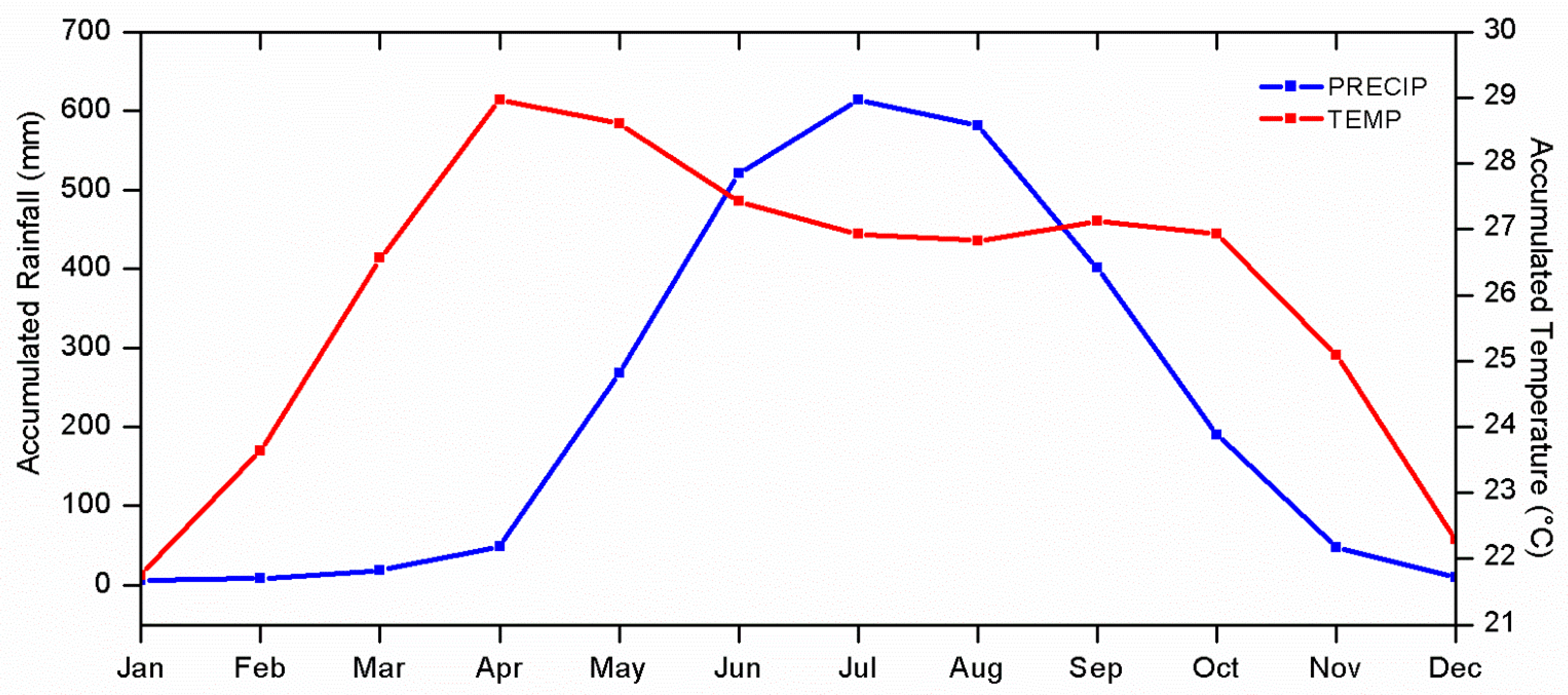
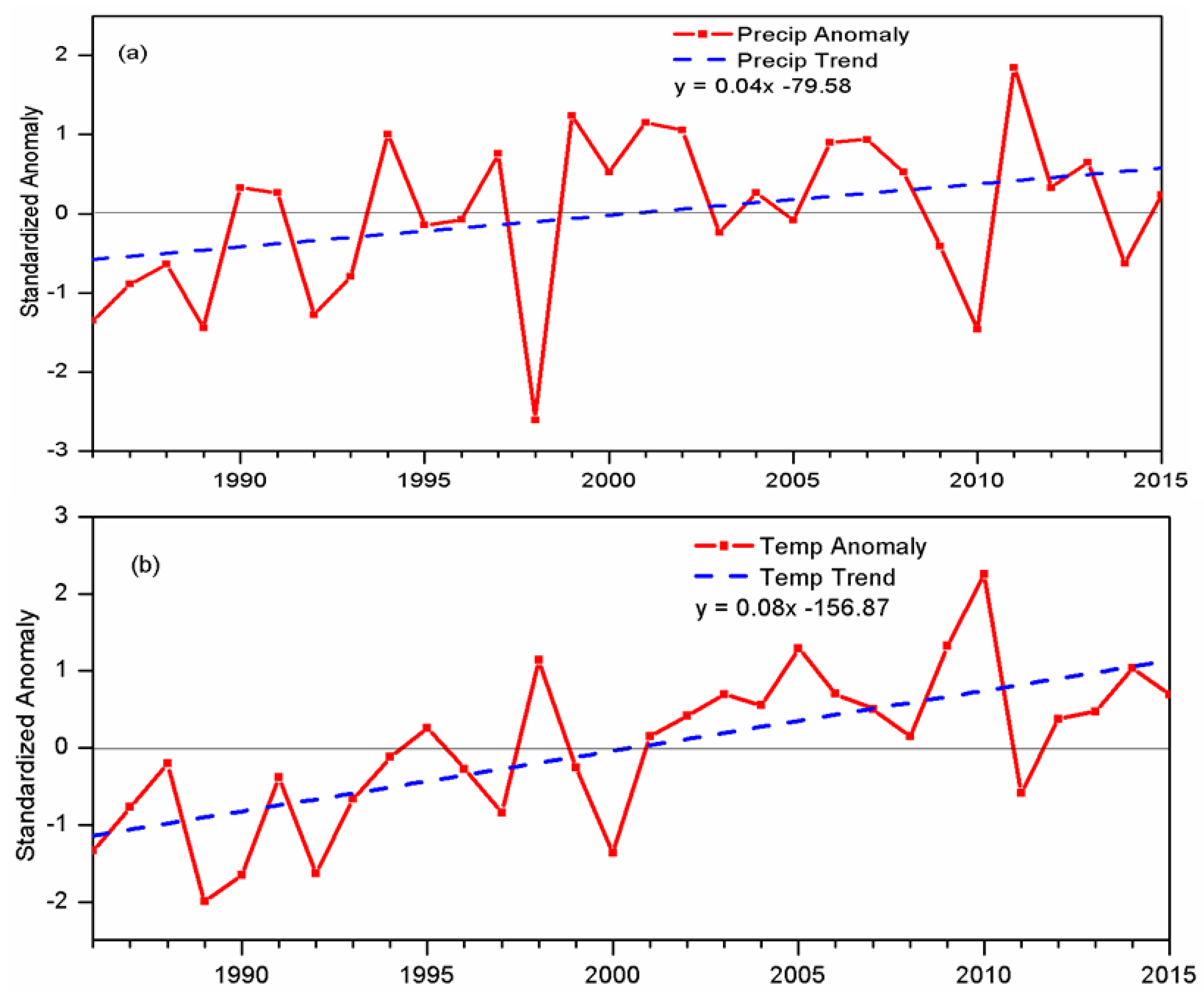
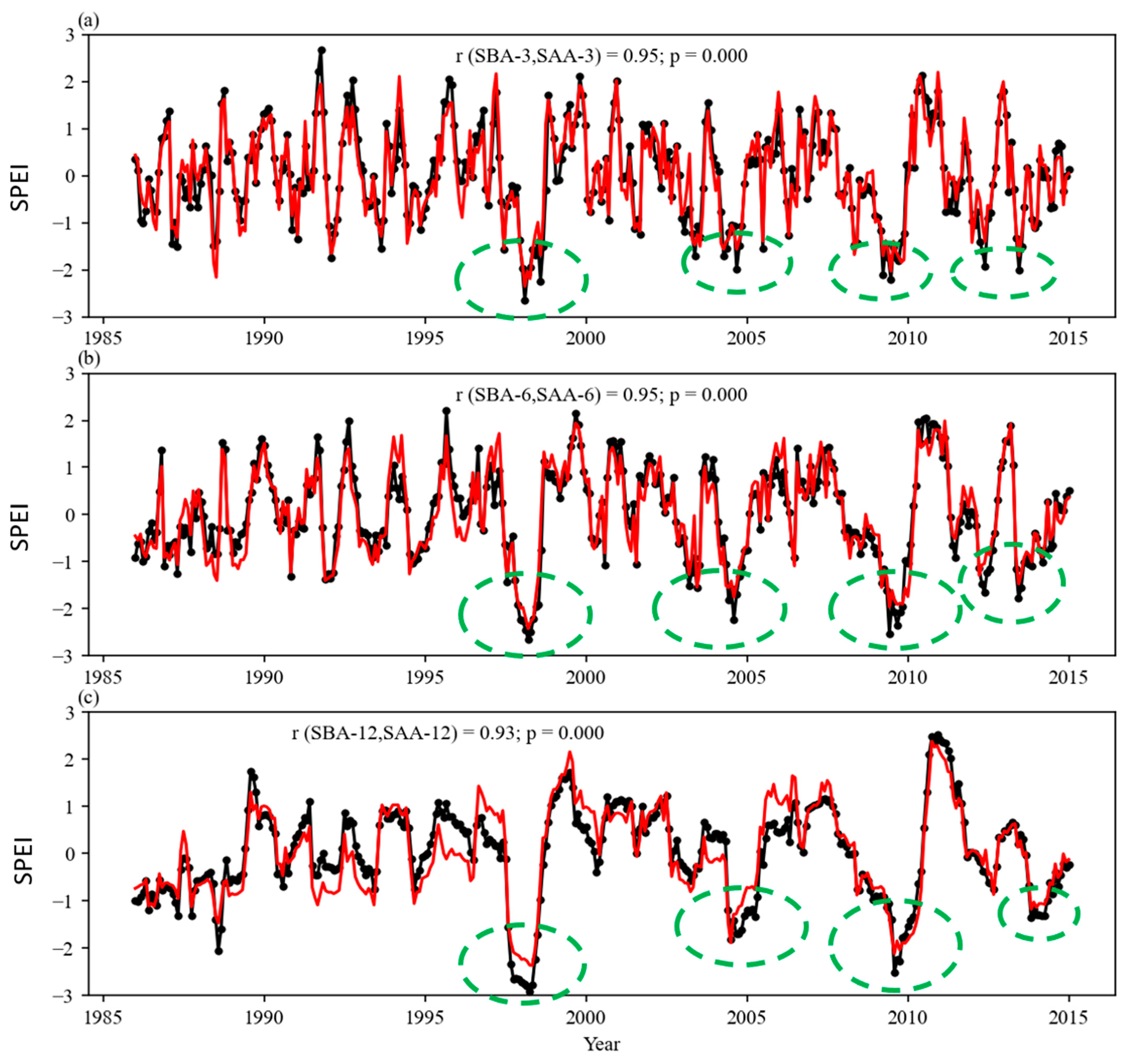
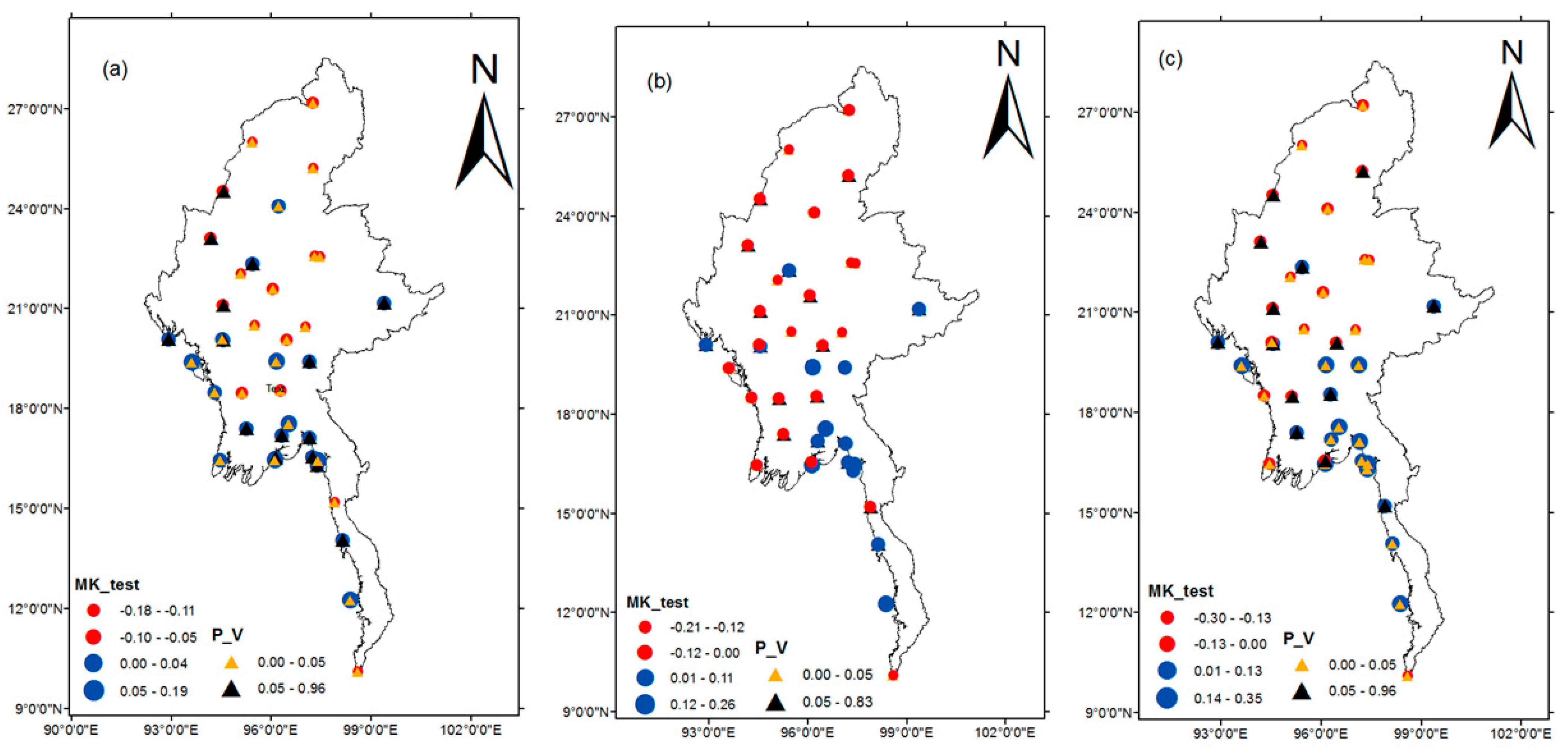
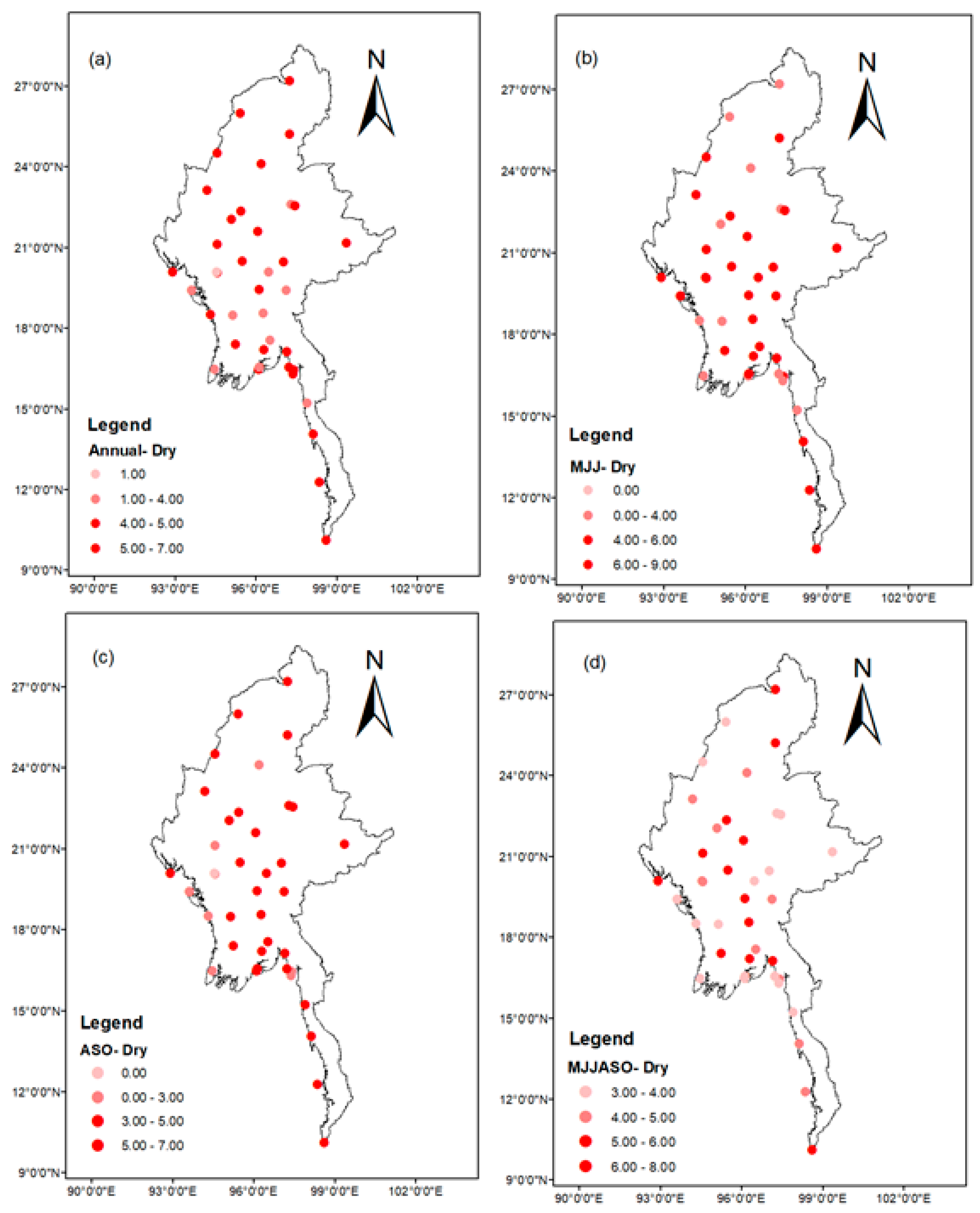



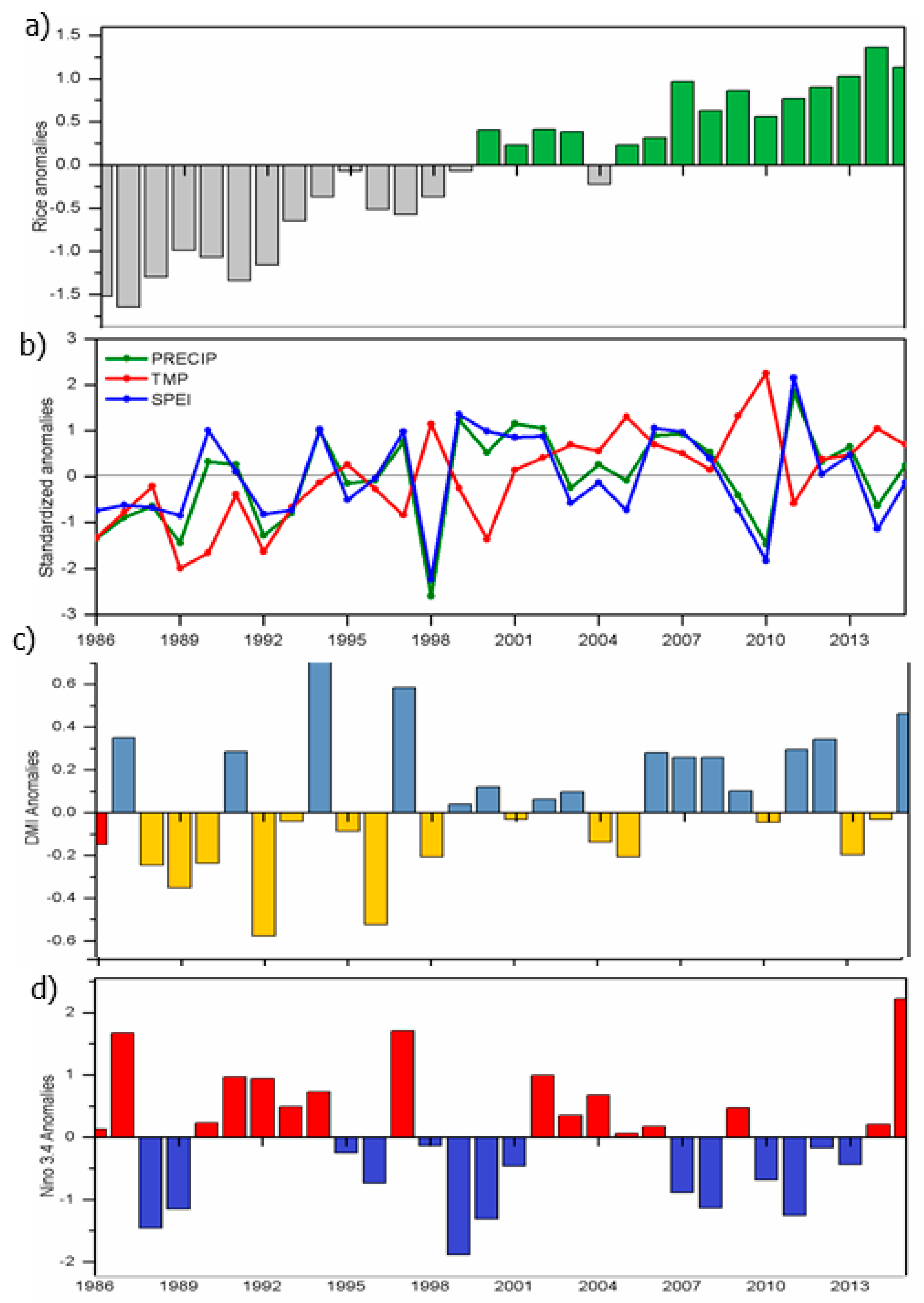
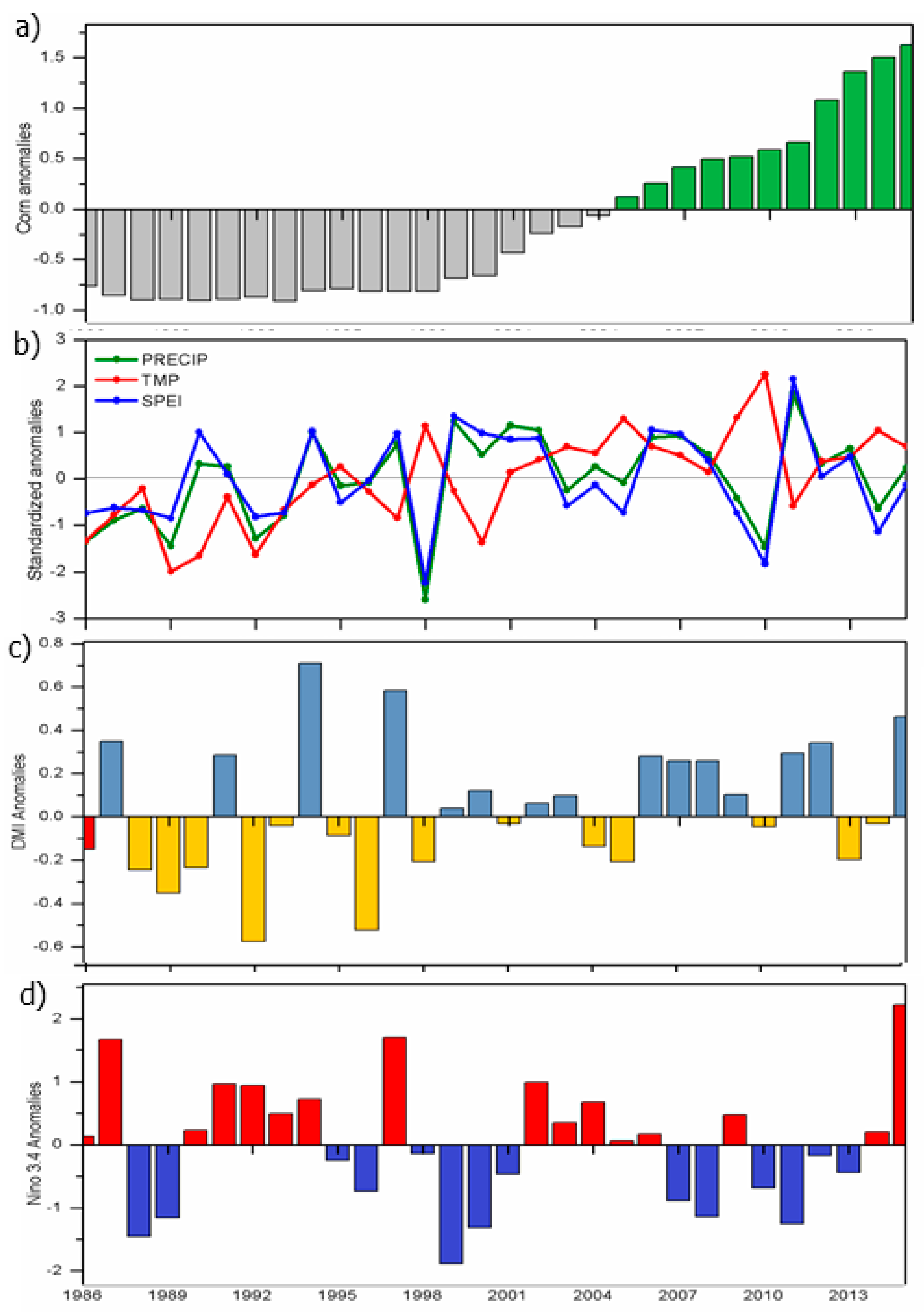
| Classes | Category | SPEI-3 (%) | SPEI-6 (%) | SPEI-12 (%) |
|---|---|---|---|---|
| Extremely wet | 1.4 | 0 | 1.72 | |
| 1.5 to 1.99 | Very wet | 4.47 | 5.91 | 3.44 |
| 1.00 to 1.49 | Moderately wet | 11.73 | 13.24 | 11.46 |
| 0.00 to 0.99 | Mildly wet | 31.84 | 29.86 | 30.94 |
| 0.00 to −0.99 | Mild drought | 32.12 | 34.93 | 38.97 |
| −1.00 to −1.49 | Moderate drought | 11.73 | 10.14 | 7.16 |
| −1.5 to −1.99 | Severe drought | 4.75 | 4.79 | 3.15 |
| Extremely drought | 1.4 | 1.13 | 3.15 |
| ENSO | IOD | |
|---|---|---|
| Annual | −0.13 (0.493) | 0.43 (0.017) |
| MJJ | −0.07 (0.695) | 0.35 (0.060) |
| ASO | 0.16 (0.384) | 0.46 (0.011) |
| MJJASO | 0.05 (0.811) | 0.44 (0.014) |
| Stat. Index | CPA | SPEI (Annual) | SPEI (MJJ) | SPEI (ASO) | SPEI (MJJASO) | PRECIP | TEMP | ENSO | IOD |
|---|---|---|---|---|---|---|---|---|---|
| R | Corn | 0.280 | 0.320 | 0.390 | 0.170 | 0.46 * | 0.42 * | −0.151 | +0.203 |
| Wheat | 0.020 | 0.160 | −0.03 | 0.110 | 0.09 | 0.31 | −0.249 | −0.133 | |
| Rice | 0.050 | −0.040 | 0.120 | −0.040 | 0.001 | −0.09 | −0.156 | −0.004 | |
| AVG | 0.117 | 0.147 | 0.160 | 0.080 | 0.046 | 0.110 | −0.185 | 0.022 |
Publisher’s Note: MDPI stays neutral with regard to jurisdictional claims in published maps and institutional affiliations. |
© 2021 by the authors. Licensee MDPI, Basel, Switzerland. This article is an open access article distributed under the terms and conditions of the Creative Commons Attribution (CC BY) license (https://creativecommons.org/licenses/by/4.0/).
Share and Cite
Sein, Z.M.M.; Zhi, X.; Ogou, F.K.; Nooni, I.K.; Lim Kam Sian, K.T.C.; Gnitou, G.T. Spatio-Temporal Analysis of Drought Variability in Myanmar Based on the Standardized Precipitation Evapotranspiration Index (SPEI) and Its Impact on Crop Production. Agronomy 2021, 11, 1691. https://doi.org/10.3390/agronomy11091691
Sein ZMM, Zhi X, Ogou FK, Nooni IK, Lim Kam Sian KTC, Gnitou GT. Spatio-Temporal Analysis of Drought Variability in Myanmar Based on the Standardized Precipitation Evapotranspiration Index (SPEI) and Its Impact on Crop Production. Agronomy. 2021; 11(9):1691. https://doi.org/10.3390/agronomy11091691
Chicago/Turabian StyleSein, Zin Mie Mie, Xiefei Zhi, Faustin Katchele Ogou, Isaac Kwesi Nooni, Kenny T. C. Lim Kam Sian, and Gnim Tchalim Gnitou. 2021. "Spatio-Temporal Analysis of Drought Variability in Myanmar Based on the Standardized Precipitation Evapotranspiration Index (SPEI) and Its Impact on Crop Production" Agronomy 11, no. 9: 1691. https://doi.org/10.3390/agronomy11091691
APA StyleSein, Z. M. M., Zhi, X., Ogou, F. K., Nooni, I. K., Lim Kam Sian, K. T. C., & Gnitou, G. T. (2021). Spatio-Temporal Analysis of Drought Variability in Myanmar Based on the Standardized Precipitation Evapotranspiration Index (SPEI) and Its Impact on Crop Production. Agronomy, 11(9), 1691. https://doi.org/10.3390/agronomy11091691










